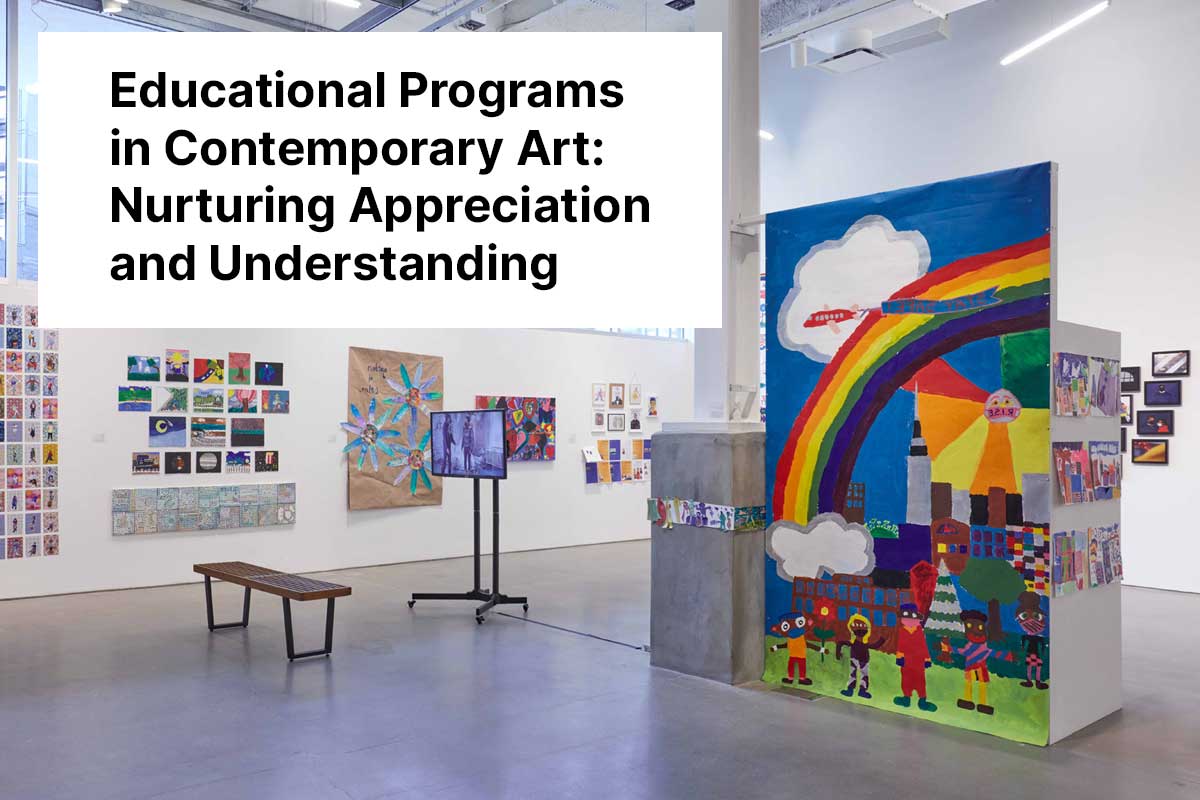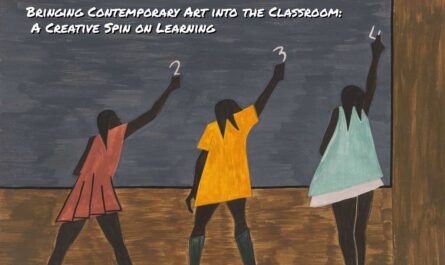With its varied and energetic quality, contemporary art sometimes leaves visitors both enthralled and confused. Unlike traditional art forms, modern art questions ideas, interacts with modern social, political, and cultural concerns, and violates standards. Modern art’s educational initiatives are rather important in helping to close the distance between the works and the audience.
Designed for both students and adults, these courses and seminars help to deepen knowledge and respect of modern art.
Why Modern Art Education Is Crucial
There are a number of reasons why modern art education is crucial:
- It clarifies the often-abstract and complicated nature of contemporary art. These programs help people connect with art on a deeper level by giving historical background, describing artistic processes, and talking about the subjects discussed.
- Embracing many perspectives and thinking critically are key components of modern art education. Through this activity, people develop a more nuanced and accepting view of the world by learning to analyze artworks from many angles.
- It encourages expressiveness and originality, which in turn helps people discover and develop their own artistic abilities.
Courses in Contemporary Art
Courses in contemporary art provide a comprehensive and structured approach to understanding and creating modern artworks, catering to various interests and skill levels from academic to online learning environments.
Academic Courses
Universities and art schools among other academic institutions provide thorough courses in modern art. From the history and philosophy of modern art to useful studio practice, these courses may address a broad spectrum of subjects. Students study several trends and genres, explore the works of eminent modern artists, and create their own artistic practices.
Courses could also offer a well-rounded education in modern art through guest lectures by working artists, gallery visits, and chances for critical debate.
Offered by organizations like the California Institute of the Arts (CalArts) and the School of the Art Institute of Chicago (SAIC), Master of Fine Arts (MFA) in Contemporary Art includes in-depth study and studio practice, thereby prepares students for professional careers in the arts.
Universities such as New York University (NYU) and the University of California, Los Angeles (UCLA) offer programs that mix historical study with modern critique, so providing a strong basis in art history and contemporary practice. • Bachelor of Arts (BA) in Art History with an eye toward Contemporary Art.
Online Courses
With the rise of digital learning platforms, online courses in contemporary art have become increasingly popular. These courses offer flexibility, allowing participants to learn at their own pace and from the comfort of their homes. Renowned institutions like the Museum of Modern Art (MoMA) and the Tate Modern offer online courses that cover everything from art history to specific contemporary art practices.
Online courses often include video lectures, interactive assignments, and discussion forums, creating an engaging and interactive learning experience.
Examples of Online Programs:
- The MoMA’s “What Is Contemporary Art?” You can take this free online lesson that goes deep into MoMA’s large collection. It includes views from artists, managers, and conservators that will help you understand the subtleties of modern art.
- The University of California, Irvine’s “Modern and Contemporary Art and Design” on Coursera lets you learn about the most important trends and artists of modern and contemporary art through interesting video lectures and hands-on tasks.
- University of Zurich’s “Contemporary Art and Its Market” on edX: Learn about the complicated world of the modern art market from top workers in the field. Find out how art is made, shown, and traded.
- The Online Learning Program at the Museum of Contemporary Art (MOCA) Los Angeles gives you access to a lot of free materials, such as video lectures, hands-on games, and guided tours of MOCA’s collection of modern art. These materials are great for both teachers and art fans.
Workshops in Contemporary Art
Hands-On Workshops
Workshops provide a more practical and immersive approach to contemporary art education. These hands-on sessions, often conducted by practicing artists, focus on specific techniques, mediums, or themes.
Participants get the opportunity to create their own artworks, experiment with different materials, and receive personalized feedback from the instructor. Workshops can range from one-day intensives to week-long retreats, catering to both beginners and advanced practitioners.
Examples of Hands-On Workshops:
- Mixed Media Techniques Workshop: Hosted by various art centers, this workshop teaches participants how to combine different materials and techniques, such as collage, painting, and digital media.
- Experimental Drawing Workshop: Offered by contemporary art studios, these workshops encourage participants to explore unconventional drawing methods and materials.
Thematic Workshops
Thematic workshops explore contemporary art through specific lenses, such as social justice, environmental issues, or digital media. These workshops often include discussions, collaborative projects, and visits to relevant exhibitions or artist studios. By focusing on particular themes, participants gain a deeper understanding of how contemporary art interacts with and responds to current global challenges.
Examples of Thematic Workshops:
Art and Activism Workshop: This program, often offered by museums and cultural centers, examines the role of art in social movements and includes activities like poster-making and public art interventions.
Environmental Art Workshop: Conducted by eco-artists, these workshops focus on creating art with sustainable materials and addressing environmental issues through creative expression.
Programs for Different Audiences
Contemporary art education programs cater to a wide range of audiences, from young students to adults, ensuring that everyone can engage with and appreciate modern artistic practices.
Programs for Students
Educational programs tailored for students aim to introduce contemporary art in an accessible and engaging manner. School partnerships with local art museums and galleries can provide students with guided tours, artist talks, and interactive activities. Summer programs and after-school clubs offer more intensive experiences, where students can develop their artistic skills and explore contemporary art in depth.
Examples of Student Programs:
- Museum School Programs: Institutions like the Whitney Museum of American Art offer school programs that include guided tours, hands-on workshops, and discussions tailored to different grade levels.
- Summer Art Camps: Programs such as the ones offered by the San Francisco Art Institute (SFAI) provide young artists with the opportunity to work on projects, learn from practicing artists, and explore contemporary art.
Programs for Adults
For adults, contemporary art programs provide a platform for lifelong learning and personal enrichment. Adult education centers, community colleges, and cultural institutions offer a variety of courses and workshops suited to different interests and skill levels. These programs not only enhance art appreciation but also offer social opportunities, connecting like-minded individuals who share a passion for contemporary art.
Examples of Adult Programs:
- Evening Art Classes: Institutions like the School of Visual Arts (SVA) offer evening classes in contemporary art practices, allowing working adults to develop their artistic skills.
- Community Art Workshops: Local art centers often provide workshops that focus on specific techniques or themes, fostering a community of art enthusiasts.
Choosing the Right Contemporary Art Course
Selecting the right contemporary art course depends on your interests, goals, and preferred learning style.
| Specialization | Description | Tips for Choosing |
|---|---|---|
| Art History and Theory | Focuses on the historical and theoretical aspects of contemporary art. | Ideal for those interested in the academic study of art and its cultural contexts. Look for programs with strong faculty and access to extensive libraries or archives. |
| Studio Practice | Emphasizes hands-on creation and developing artistic techniques. | Best for aspiring artists who want to enhance their practical skills. Choose courses with well-equipped studios and opportunities for exhibitions. |
| Digital Media and Technology | Explores art created with digital tools and new media. | Suitable for those interested in multimedia art, digital installations, or interactive art. Opt for courses offering the latest technology and software training. |
| Curatorial Studies | Prepares students for careers in art curation and museum management. | Ideal for those looking to work in galleries, museums, or as independent curators. Select programs with internship opportunities and connections to art institutions. |
| Art and Social Practice | Examines art’s role in social change and community engagement. | Perfect for those who want to integrate art with activism or community work. Look for programs with strong community partnerships and practical project work. |
| Art Market and Management | Focuses on the business side of the art world, including marketing, sales, and gallery management. | Best for those interested in the commercial aspects of art. Choose courses that offer networking opportunities with art market professionals and practical business training. |
Tips for Choosing the Best Course
- Identify Your Interests: Determine what aspect of contemporary art excites you the most.
- Consider Your Goals: Are you aiming for an academic career, a professional artist path, or a role in art management?
- Research Faculty and Facilities: Look into the qualifications of the instructors and the resources available.
- Check for Practical Opportunities: Internships, studio access, and exhibition opportunities can greatly enhance your learning experience.
- Flexibility and Format: Decide if you prefer in-person, online, or hybrid learning environments to fit your schedule and learning style.
Educational programs in contemporary art are vital for fostering a deeper understanding and appreciation of this dynamic field. By offering a range of courses and workshops tailored to diverse audiences, these programs break down barriers, making contemporary art accessible and engaging.
Whether through academic courses, online learning, or hands-on workshops, contemporary art education nurtures creativity, critical thinking, and cultural awareness, enriching the lives of participants and contributing to a more informed and appreciative society.

